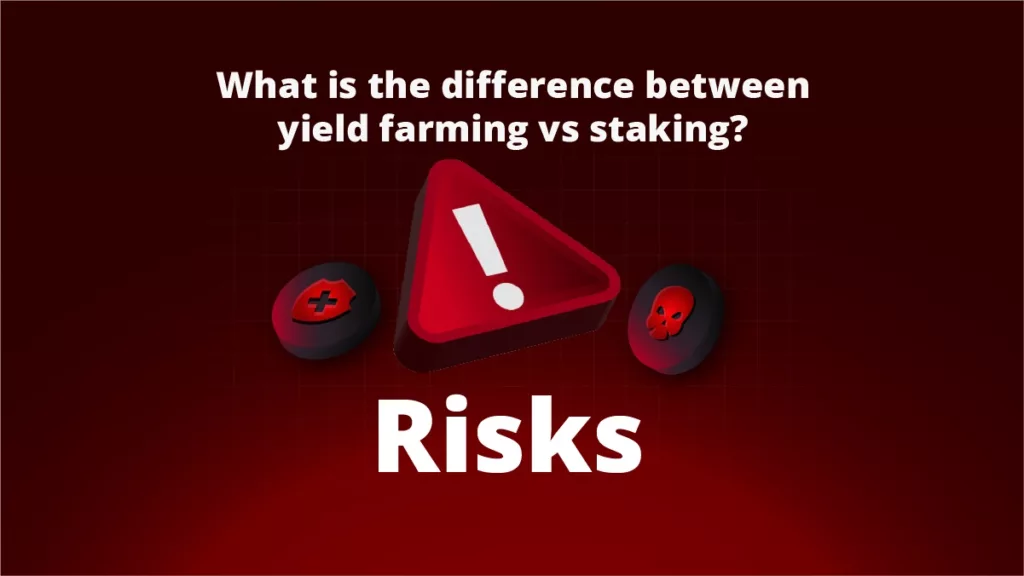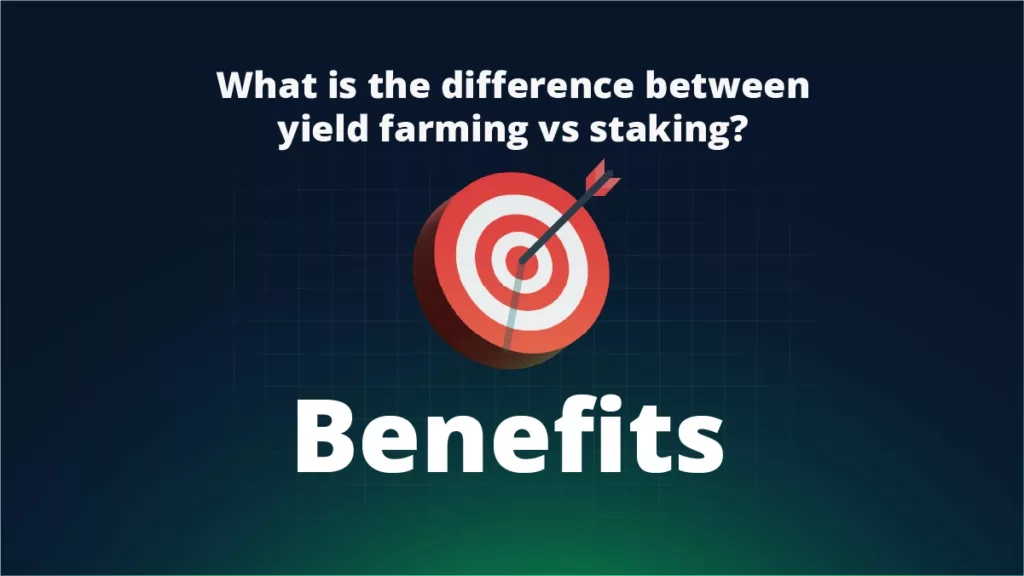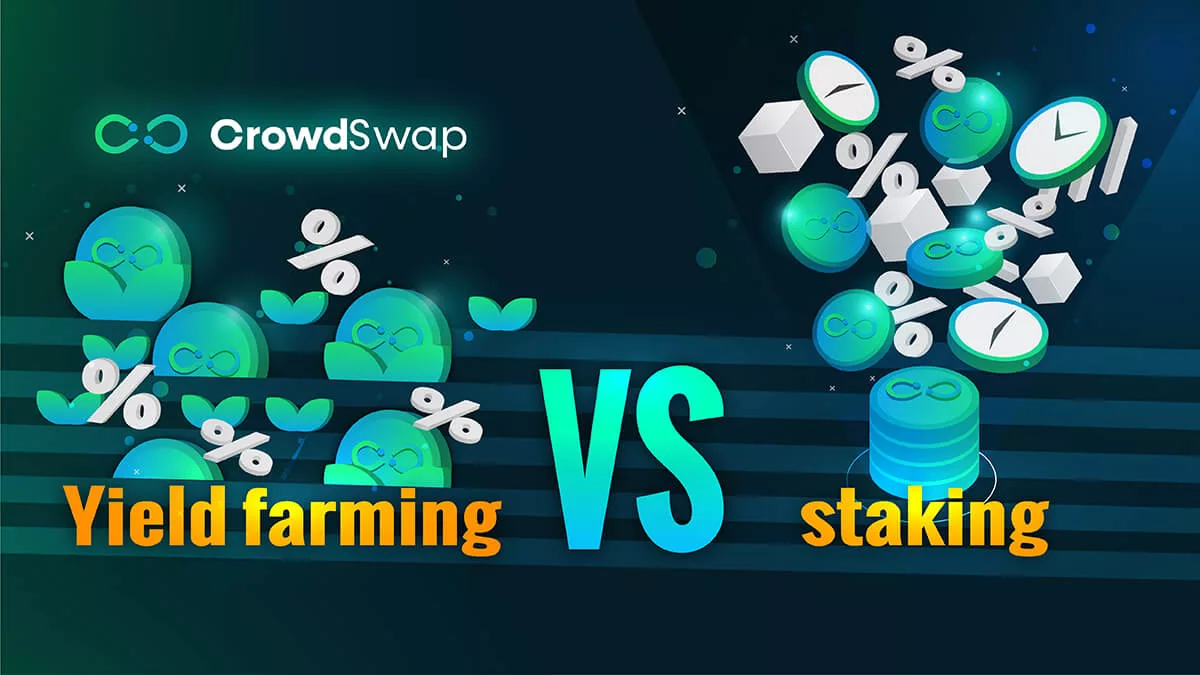In the world of decentralized finance (DeFi), two important ideas stand out: Yield Farming vs Staking. They may seem similar, but they have key differences. Explore our guide to understand Staking and Yield Farming concepts and decide which fits your goals better.
What is staking crypto?
Staking crypto involves holding a certain amount of cryptocurrency in a digital wallet to support the operations of a blockchain network. By staking, you help validate transactions and secure the network, and in return, you earn rewards in the form of additional coins. It’s like putting your money to work while helping to maintain the blockchain’s integrity and functionality.
Staking crypto is like saving money in a bank but for digital currencies
Instead of earning interest, you help validate transactions on a blockchain network by holding onto your cryptocurrency in a digital wallet. For example, you can stake it in the Ethereum 2.0 network if you have Ethereum. By doing this, you support the network’s security, and in return, you earn rewards in the form of more Ethereum. It’s like getting paid for helping out with the bank’s work.
Staking is also known as a way of earning passive income. This means that an investor should only put tokens into a staking app, sign a smart contract, and then sit back and watch the earned benefits transferred into their wallets.
Staking crypto is considered a low-risk investment based on decentralized systems. It has been one of the most popular ways of investment in bearish markets.
Read more: What is staking crypto?
What is yield farming crypto?
A DeFi protocol is like a digital system or set of rules that allows people to do financial activities, such as borrowing, lending, or trading, using cryptocurrency instead of traditional money. It’s like a digital bank or stock market, but it operates on the internet without needing a physical location or traditional financial institutions.
Yield farming in crypto involves using your cryptocurrency to provide liquidity to DeFi protocols.
Yield farming in crypto involves using your cryptocurrency to provide liquidity to DeFi protocols
(Liquidity means making your cryptocurrency available for others to use in DeFi protocols. It’s like adding your money to a pool that others can borrow from or trade with easily.) By doing so, you earn rewards in the form of additional tokens or interest. Essentially, it’s like lending out your crypto or participating in various DeFi activities to maximize your returns.
To explain more with an example, let’s say that yield farming in crypto is like planting seeds in a garden to grow more crops. Instead of seeds, you put your cryptocurrency into special digital gardens called DeFi platforms. These platforms use your crypto to do different things, like lending or trading. In return for letting them use your crypto, you get rewarded with more cryptocurrency. So, just like how you get more crops by farming, you get more cryptocurrency by yield farming.
Yield farming can be risky for a few reasons. First, it often involves interacting with new or less-established DeFi projects, which may not have been thoroughly tested for security or reliability. Additionally, the rewards offered in yield farming can fluctuate, meaning you might not always earn as much as you expect. Furthermore, there can be smart contract bugs or vulnerabilities that could result in loss of funds. Lastly, the cryptocurrency market itself is volatile, so the value of your investments can go up or down unexpectedly. It’s important to thoroughly research and understand the risks before participating in yield farming.
Read more: What is yield farming?
What is the difference between yield farming vs staking?
The difference between yield farming vs staking lies in the potential rewards and risks for investors.
Yield farming offers higher potential profits but comes with risks like price changes, protocol issues, and losing collateral. On the other hand, staking offers lower but steadier rewards with risks such as penalties and network delays.
Additionally, yield farming adds liquidity to trading platforms, making transactions easier, while staking secures blockchain networks for faster and cheaper transactions.

Yield Farming Risks
Yield farming comes with its share of risks, but understanding them can help investors make informed decisions. These risks can be divided into two categories: those influenced by the market and regulations (such as market volatility and impermanent loss) and those related to the DeFi platform itself (such as rug pulls and smart contract hacks).
Market Volatility
Like all assets, cryptocurrencies can experience rapid and unpredictable price changes, known as volatility. This volatility can affect yield farming returns, so investors should stay conscious.
Impermanent Loss
When providing liquidity to a pool, the value of deposited assets can change, leading to impermanent loss. This occurs when the price of tokens in the pool shifts, impacting asset value. Higher volatility increases the risk of impermanent loss.
Read more: What is Impermanent Loss?
Rug Pulls
Rug pulls occur when scam projects attract investors only to disappear with their funds before the project launches. For example, inspired by the Squid Game TV series, the SQUID token saw a dramatic price drop, leaving investors with worthless assets. It soured by % 110,000 at the peak of its popularity. One day, suddenly, the crypto dropped from $2,861.80 to $0.0007926 in a matter of seconds.

Smart Contract Hacks
DeFi platforms rely on smart contracts, which can contain vulnerabilities exploited by hackers. Even well-established projects are not resistant to such attacks, highlighting the importance of investor caution and due diligence.
Staking Risks
Staking also comes with its own set of risks.
Slashing Penalties
In proof-of-stake (PoS) blockchain networks, validators can experience slashing penalties for malicious behavior or network downtime, resulting in a loss of staked assets.
Lock-up Periods
Staking often requires locking up funds for a certain period, during which investors may be unable to access or withdraw their assets.
Network Congestion
High network congestion can lead to delays or failures in staking transactions, impacting rewards and potentially resulting in missed opportunities.
Protocol Vulnerabilities
Similar to yield farming, staking protocols rely on smart contracts that may contain bugs or vulnerabilities, exposing staked assets to potential risks.

The benefit of Yield Farming
Passive Income
By providing liquidity to DeFi platforms, yield farmers can earn passive income through interest, trading fees, or token rewards generated by their deposited assets.
Potential for High Returns
Yield farming provides the potential for significant returns by staking various tokens in decentralized liquidity pools, often offering rewards in the form of additional tokens or interest.
Liquidity Provision
Yield farming contributes to the liquidity of DeFi markets by providing assets for trading and borrowing, improving market efficiency, and reducing slippage.
The Benefits of Staking
Passive Income
Staking allows users to earn rewards or interest on their cryptocurrency holdings, providing a source of passive income without the need for active trading.
Low Volatility
Unlike trading in the open market, staking is generally less susceptible to price fluctuations, providing a more stable investment option for participants.
Low Risk
Staking typically involves minimal risk as it shields participants from market volatility. As long as the network remains secure, stakers can anticipate stable returns on their investment.

Yield Farming vs Staking: A Comparison for Short and Long-Term Investments
For short-term or long-term investments, the choice between yield farming vs staking depends on various factors, including liquidity needs, risk tolerance, and return expectations
Yield farming offers more flexibility and liquidity since investors can withdraw their tokens from liquidity pools at any time. This can be advantageous for short-term strategies where quick access to funds is essential. However, yield farming typically involves higher risks and may offer lower returns compared to staking.
Staking, on the other hand, provides more stable returns but often requires locking up tokens for a predetermined period. While this limits liquidity in the short term, it can be suitable for investors willing to commit their assets for a short period in exchange for more predictable returns.
Ultimately, the better option for any investment in yield farming vs staking depends on your preferences and circumstances. It’s essential to research and consider the risks and rewards of each option before making a decision. Here are some factors to consider:
- The expected annual percentage yield (APY) of each protocol
- Lock-up period
- Withdrawal fees for each protocol
- Volatility and liquidity of the underlying assets
- Security and reputation of the protocol
How to invest in Yield Farming vs Staking
Investing in yield farming vs staking is relatively straightforward. For yield farming, you can start by selecting a platform that offers yield farming opportunities. Then, you’ll need to deposit your cryptocurrency into the platform’s liquidity pools and follow the provided instructions to begin earning rewards. Staking has the same process, too. CrowdSwap DEX is a good choice for investing in its earning opportunities for different reasons, such as simplicity, being very user-friendly, and high APYs and rewards. Watch the following videos to learn more.
Trade Effortlessly
Ready to dive deeper? Our crypto exchange is simple and user-friendly, making trading a breeze
Conclusion
In conclusion, both staking and yield farming offer distinct advantages and drawbacks. When deciding which avenue to pursue for investment, it is crucial to assess your investment capital and preferences regarding strategy details. The decision ultimately depends on individual investment objectives, with factors such as risk tolerance, investment horizon, and capital allocation playing key roles in the selection process. In essence, there’s no one-size-fits-all answer, as each investor’s unique circumstances and goals shape their preferred approach to investment.
FAQ
Is yield farming still profitable?
The short answer is yes. Yield farming can still be a profitable investment strategy.
Which one is suitable for generating higher returns, yield farming or staking?
Yield farming suits investors looking to generate higher returns than traditional investments such as stocks and bonds.
Why can staking be a safe option?
Staking can be a safe option because it contributes to network security and offers predictable returns, reducing exposure to market volatility. Additionally, staking rewards provide a passive income stream, enhancing financial stability over time.













